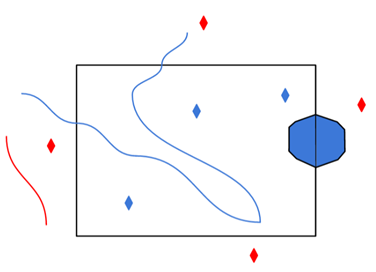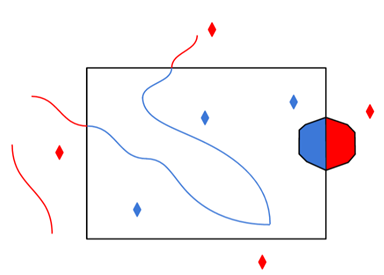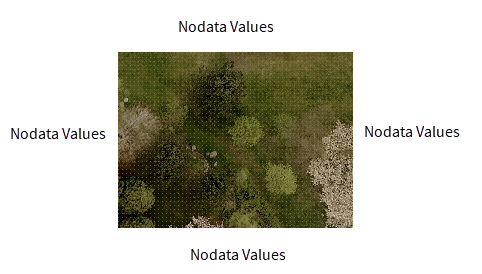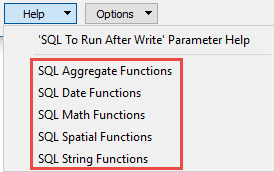|
About Database Connections |
|---|
|
Database formats include a Database Connection parameter that defines and stores authentication information. For general information about sharing database connections, please see Using Database Connections. Note that Database Connection parameters differ slightly, depending on context and/or database format. |
|
Connection From the Connection parameter in a database format, you can do one of the following:
|
Database Connection
File Geodatabase
The geodatabase file from which the data is to be read.
Constraints
Click the Browse button to select tables for export. You may only select this after you’ve completely specified the database connection.
After you click the Browse button, a search window appears while the system compiles a table list from the database.
Once the Select Tables dialog appears, you can select one or more tables. Click OK to dismiss the window and add the selected table name(s) to the Tables parameter.
Enter any SQL where clause that constrains the attributes of the layers selected in the layer list (for example, NUMLANES=2).
Used for translating spatial data only. When this box is checked, non-spatial tables, relationships, domains, and subtypes will not be translated. If this directive is specified when generating a workspace or mapping file, then no schemas will be returned for non-spatial tables.
Specifies whether or not to resolve the domain code found in feature classes and tables into the domain value.
This means that when an attribute of a feature has a coded value domain associated with it, another attribute will also be added that represents the textual description of the coded attribute. The new attribute will be <attribute-name>_resolved, where <attribute-name> is the name of the attribute containing the code.
Specifies whether or not to resolve the subtype field values found on feature classes and tables into the name of the actual subtype.
Specifies whether to read the network portion of network features. When checked, junctions will be read as points (geodb_point) and edges will be read as lines (geodb_polyline). Additionally, none of the network related attribution will be supplied on the features.
Checking this option can significantly speed up reading of network features.
Determines whether to read relationship features present in a source dataset. When this parameter is checked, feature types containing simple relationships will be ignored, and feature types containing attributed relationships will be treated as non-spatial tables. When this parameter is unchecked, relationships will be read normally as either simple or attributed. The speed of reading features is vastly improved if relationships are ignored.
Determines whether complex edge features should be split. When split, complex edge features are read at the element level rather than the feature level. The element level represents the logical view of the geometric network. As a result, no network connectivity information is lost.
Note: For information on the attributes that each FME feature stores when this option is checked, please see the Esri Geodatabase Reader/Writer > Reader Overview > Reader Keywords > SPLIT_COMPLEX_EDGES.
Specifies whether or not to split multi-part annotations into separate features for each 'element' when reading. If this parameter is checked, a single feature for each element (usually a word) in a multi-part annotation will be produced on reading, resulting in feature-specific attributes such as angle and text position being stored according to the location of each element. If this parameter is unchecked, multi-part annotations will be read normally, as a single feature storing a single set of attributes describing the positioning of the text.
When set to Features, the reader outputs features stored within tables.
When set to Metadata, provides the ability to read table-level metadata. In this mode, the reader outputs one feature per feature type. The geodb_type of the feature is geodb_metadata and the entire XML metadata document belonging to the Geodatabase table is found in the attribute geodb_metadata_string.
Where applicable, the following attributes are also supplied:
- fme_feature_identifier – Indicates the name of the object ID field,
- fme_contains_spatial_column – Indicates whether the table has a geometry column (or, in Esri ArcGIS terms, whether the table is a feature class)
- fme_geometry{0} – Indicates the types of geometry the feature class contains
- fme_dimension – Indicates whether the feature class is 2D or 3D.
If the table is a feature class, the geometry of the metadata feature returned is a polygon, representing the extents of the feature class, and the coordinate system of the feature class also gets set on the feature.
When reading metadata, the Feature Type parameters are used to determine which feature types should have metadata read from them.
Use this parameter to expose Format Attributes in Workbench when you create a workspace:
- In a dynamic scenario, it means these attributes can be passed to the output dataset at runtime.
- In a non-dynamic scenario, this parameter allows you to expose additional attributes on multiple feature types. Click the browse button to view the available format attributes (which are different for each format) for the reader.
This parameter controls how Geodatabase aliases are used.
None – Aliases are ignored.
Replace Attribute Names with Aliases – (only applicable when adding a Reader) Attributes on feature types will be named for their aliases rather than their official names. A geodb_feature_class_alias attribute will be included on each feature. Use this mode when the target format should create feature types using the aliases as attribute names.
Note: To change the alias mode after you select Replace Attribute Names with Aliases, remove the reader from the canvas and re-add it with your preferred alias mode setting.
Expose Aliases as Metadata Attributes – For each attribute read, a second <name>_alias attribute will be added that stores the alias for the attribute in question. A geodb_feature_class_alias attribute will also be included on each feature. Use this mode when the target format is Geodatabase and the aliases should be preserved during feature class and table creation.
Note: If you want to make changes after you select Expose Aliases as Metadata Attributes, you can only change the setting back to None. To change the alias mode to Replace Attribute Names with Aliases, remove the reader from the canvas and re-add it with your preferred alias mode setting.
A search envelope (also known as a bounding box) is a rectangular area that defines a geographic area. In FME, the easiest way to define a search envelope is to use search envelope parameters.
Defining a search envelope is the most efficient method of selecting an area of interest because FME will read only the data that is necessary – it does not have to read an entire dataset. Search Envelope parameters apply to both vector and raster datasets and can be particularly efficient if the source format has a spatial index.
Most FME readers have parameters to define the search envelope of data that is being read:
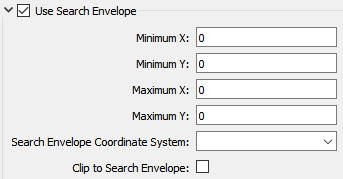
The parameters include the x and y coordinates of the bounding box as well as a parameter that defines the coordinate system.
How to Define the Bounding Box
Using the minimum and maximum x and y parameters, define a bounding box that will be used to filter the input features. Only features that intersect with the bounding box are returned. Note that the bounding box intersection is not a full geometry intersection (based on spatial relationships) that would be returned by a transformer like the SpatialFilter.
Note: If all four coordinates of the search envelope are left at 0, the search envelope will be disabled even if this option is checked.
Search Envelope Coordinate System
Specifies the coordinate system of the search envelope if it is different than the coordinate system of the data. The coordinate system associated with the data to be read must always be set if this parameter is set.
If this parameter is set, the minimum and maximum points of the search envelope are reprojected from the Search Envelope Coordinate System to the reader’s coordinate system prior to applying the envelope.
The underlying function for Use Search Envelope is an intersection; however, when Clip to Search Envelope is checked, a clipping operation is also performed.
- When checked (set to Yes), this option instructs FME to clip features to the exact envelope boundary. FME removes any portions of imported features being read that are outside the search envelope.
- When left unchecked (set to No), features that overlap the boundary will be included in their full (unclipped) form.
|
Clip to Search Envelope: No |
Clip to Search Envelope: Yes |
|---|---|
|
Any features that cross the search envelope boundary will be read, including the portion that lies outside of the boundary.
|
Any features that cross the search envelope boundary will be clipped at the boundary, and only the portion that lies inside the boundary will be read.
|
|
The search envelope includes the bounding box and the extent of the raster.
|
The search envelope includes only the area within the bounding box. The raster size will still match the bounding box, but the area without data will be filled with Nodata values to represent the absence of data, if the source raster has them. Raster Nodata may be a single value across all bands, a single value per band, or a separate alpha or transparency band that indicates the lack of data values (this is more common in images than other types of rasters).
|
Advanced
Geodatabase annotations offer a rich set of options to place text which are often not supported or do not directly translate to other formats. By enabling this option, richer text representations are broken into simpler representations that preserve text style and placement.
To maintain accurate placement, text elements are split into separate features on line breaks, format changes, irregular character spacing, and on any curves. This option also implies that multi-part annotations will be split (see the Split Multi-Part Annotations parameter above).
Each resulting feature will have a rotation angle and a point representing the bottom left corner of the text. All the text will be bottom, left-justified without an X or Y offset.
Each feature will contain all the attributes of the original text element including all the Geodatabase format attributes. The annotation related format attributes represent the current part and not the original text element. An additional geodb_text_part_count format attribute is added to indicate the part index of the original text element.
Specify the type of memory optimizations that are used when reading multipatches with textures. The default behavior to cache texture should be used in most scenarios as it will result in better performance. If, however, memory is an issue and there are many multipatch features with associated texture materials (like the buildings of a city), then consider disabling caching to improve memory usage.
- Yes (default): Textures will be stored in local texture caches and no effort will be made to clean them. This results in better performance but higher memory usage over time.
- No: Extra effort will be made to clear texture caches. This may result in slower performance.
Specifies whether a check should be performed on features read from Geodatabase to determine if they are simple.
Note: This is an expensive check, and it impacts reader performance.
If this parameter is set to Yes, the format attribute geodb_feature_is_simple is set to yes if the geometry is simple, and no if it is not.
In some programs (for example, ArcGIS Pro), GlobalID and GUID attributes contain braces:

When set to Yes, this parameter removes the braces from the GlobalID and GUID attributes for compatibility with programs where these attributes do not contain braces.
The default is No.
Specifies whether feature-linked annotations should have their text, angle, and position properties merged as attributes onto the main feature to which they are linked, when reading.
- Yes: This will produce a list attribute (as detailed in Annotations), with all annotation attributes set. The annotation table(s) does not need to be explicitly read.
- No: Feature-linked annotations will be read as annotations when encountered.
Specifies whether the reader should prefer reading arcs using the three-point representation. When selected, FME will attempt to retrieve arcs from the geodatabase in this form.
This parameter allows for the execution of SQL statements before opening a table for reading. For example, it may be necessary to create a temporary view before attempting to read from it.
For detailed information about SQL functions, click the corresponding menu item in the .
Available menu options depend on the format.
Multiple SQL commands can be delimited by a character specified using the FME_SQL_DELIMITER directive, embedded at the beginning of the SQL block. The single character following this directive will be used to split the SQL block into SQL statements, which will then be sent to the database for execution. Note: Include a space before the character.
For example:
FME_SQL_DELIMITER ; DELETE FROM instructors ; DELETE FROM people WHERE LastName='Doe' AND FirstName='John'
Multiple delimiters are not allowed and the delimiter character will be stripped before being sent to the database.
Any errors occurring during the execution of these SQL statements will normally terminate the reader or writer (depending on where the SQL statement is executed) with an error. If the specified statement is preceded by a hyphen (“-”), such errors are ignored.
This parameter allows for the execution of SQL statements after a set of tables has been read. For example, it may be necessary to clean up a temporary view after creating it.
For detailed information about SQL functions, click the corresponding menu item in the .
Available menu options depend on the format.
Multiple SQL commands can be delimited by a character specified using the FME_SQL_DELIMITER directive, embedded at the beginning of the SQL block. The single character following this directive will be used to split the SQL block into SQL statements, which will then be sent to the database for execution. Note: Include a space before the character.
For example:
FME_SQL_DELIMITER ; DELETE FROM instructors ; DELETE FROM people WHERE LastName='Doe' AND FirstName='John'
Multiple delimiters are not allowed and the delimiter character will be stripped before being sent to the database.
Any errors occurring during the execution of these SQL statements will normally terminate the reader or writer (depending on where the SQL statement is executed) with an error. If the specified statement is preceded by a hyphen (“-”), such errors are ignored.
Geometry
When creating donut geometries, this parameter specifies the criteria that FME will use to detect the geometric properties of the donut(s).
- Orientation Only – FME will detect donut geometry only based on orientation of the rings. Shapefile specifications state that outer boundaries of donut geometries must have clockwise orientation, and any donut holes must have counter-clockwise orientation. This option shall preserve the order of the areas.
- Orientation and Spatial Relationship – FME will detect donut geometry initially by orientation, and will perform additional geometric validation by analyzing the spatial relationships between the donut’s outer rings and holes. If any invalid donut geometries are identified, FME will attempt to correct geometric anomalies (for example, holes larger than outer ring, holes within holes, etc.).
If your dataset is supposed to have holes but FME does not correctly produce them, select Orientation and Spatial Relationship.
Note: There can be a significant difference in performance when reading very large datasets.
